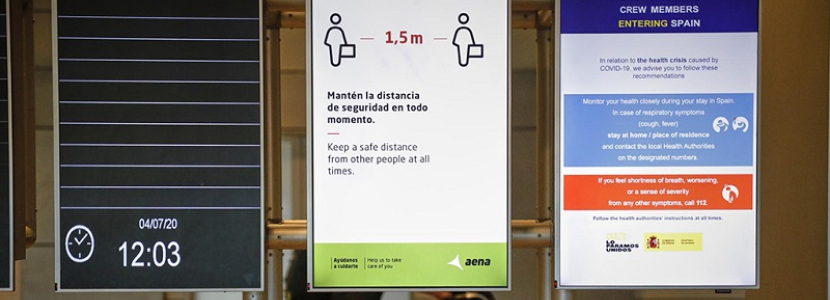
In June, Barajas registered the highest number of passengers in the network with 194,734
Aena's airport network began to recover traffic at the end of June in a progressive manner, reaching more than one million passengers in the whole month compared to 267,671 in May.
However, due to the restrictions on mobility imposed until 21st June, the figure for passengers in June represents a fall of 96.1% compared to the same month in 2019.
The recovery at the end of the month is reflected in the gradual increase in the number of operations, from an average of between 200 and 300 daily flights at the beginning of May to around 400 at the beginning of June, over 1,000 at the end of the month and 2,000 daily operations at the beginning of July.
During the month of June, the airports of the Aena network had 43,640 aircraft movements, 80.7% less than a year earlier.
Of the total number of passengers, 317,570 did so on international routes, 98.4% less than a year earlier, while 717,038 travelled on domestic routes, 91% less.
In June, Adolfo Suárez Madrid-Barajas airport recorded the highest number of passengers in the network with 194,734, representing a decrease of 96.5% compared to the same month in 2019. It is followed by Josep Tarradellas Barcelona-El Prat, with 148,903 (-97.1%); Palma de Mallorca, with 127,555 (-96.7%); Gran Canaria, with 106,541 (-89.1%), and Tenerife Norte-Ciudad de la Laguna, with 99,703 (-80.6%).
In terms of the number of operations, the airports that recorded the highest number of movements in June were airports that had mainly non-commercial activity, such as Madrid-Cuatro Vientos, with 4,693 operations, Sabadell, with 4,163, or Jerez, with 2,661.
As for the airports that maintained commercial activity, the airport that recorded the highest number of movements in June was Adolfo Suárez Madrid-Barajas, with a total of 3. 747 (-90.1%); followed by Josep Tarradellas Barcelona-El Prat, with 2,753 flights (-91.4%); Gran Canaria, with 2,382 (-74.8%); Palma de Mallorca, with 2,286 (-91.3%), and Tenerife Norte-Ciudad de La Laguna, with 1,980 (-68.6%).
More than 1,300 medical cargo and repatriation flights
During the period of the state of alert, the airports of the Aena network have operated about 1,340 essential flights. Of this total, some 750 flights have been for repatriation and return and more than 590 cargo flights for the supply of medical supplies to deal with the pandemic.
In June, 45,237 tons of cargo were transported throughout the network, 41.4% less than in the same month in 2019, due to the fact that a large part of the usual cargo is transported by commercial passenger aircraft.
The four airports that recorded the greatest traffic of goods were Adolfo Suárez Madrid-Barajas, with 22,992 tons (-47.8%); Josep Tarradellas Barcelona-El Prat, with 6,837 (-49.3%); Zaragoza, 5,566 tons (-25.1%), and Vitoria, with 5,083 tons (-6.1%).
Sanitary controls
Following the end of the state of alert and the elimination of restrictions on the mobility of persons, Aena is working in coordination with the health and transport authorities of the Spanish Government, as well as with the Member States of the European Union and the international airport associations (ACI) and airlines (IATA).
Aena has already implemented in its 46 airports and two heliports in Spain all the recommendations on cleanliness, safety distance, hygiene and communication of the European Aviation Safety Agency (EASA) and the European Centre for Disease Control and Prevention (ECDC), which have been transposed into regulations in Spain through a royal decree.
Since May 15, the Ministry of Health, through the Foreign Health Service, has been carrying out health controls on the arrival of passengers from abroad, which have been reinforced in accordance with the opening of borders.
To carry out these controls, the Ministry of Health has the support of Aena, both in terms of human and technological resources. In the first case, two companies provide back-up health personnel support services at all airports. The amount to reinforce these services, for which more than 1,000 people have joined, amounts to almost
In the second case, through the installation of thermographic cameras that allow the taking of temperature of the passengers and with the technological development of the 'Passenger Location Card' (PLC).
The controls established in health matters incorporate three security filters, with temperature recording, document control (PLC) and visual control.
In addition, suspicious cases are passed on to a secondary control where health personnel assess the clinical and epidemiological situation of the passenger.
Credits https://www.agenttravel.es/noticia-038569_Los-aeropuertos-recuperan-el-trafico-progresivamente-con-mas-de-un-millon-de-pasajeros-en-junio.html


